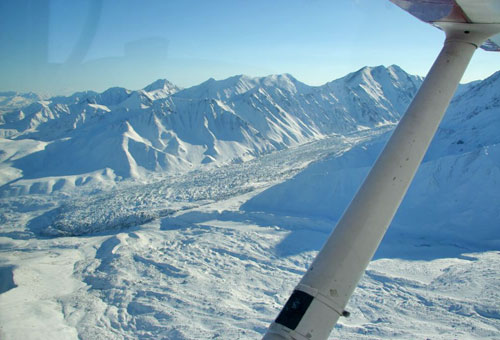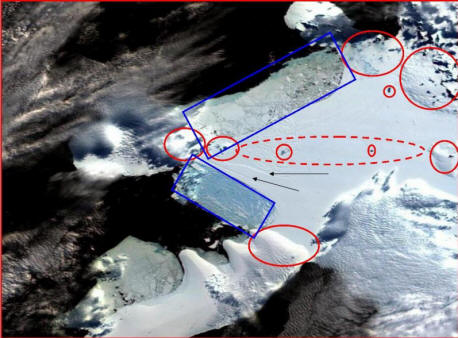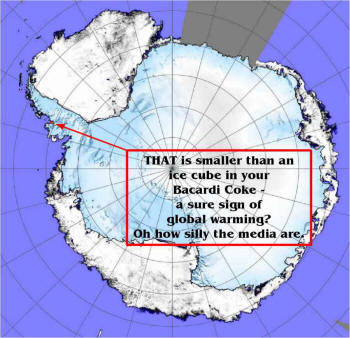NORWAY
The Norwegian daily Bergens Tidende
AGENCE-FRANCE PRESSE
Sunday, May 24, 1998
Norway's glaciers growing at record
pace. The face of the Briksdal glacier, an off-shoot of the
largest glacier in Norway and mainland Europe, is growing by an
average 7.2 inches (18 centimeters) per day.
To see mass balance of Norwegian
glaciers: http://www.nve.no/
Choose "English" (at top of the page), choose "Water," then
"Hydrology," then "Glaciers and Snow" from the menu. You'll see
a list of all significant glaciers in Norway.
CANADA
-
Helm Glacier
-
Place Glacier
-
France
-
Mt. Blanc
ECUADOR
SWITZERLAND
KIRGHIZTAN
RUSSIA
GREENLAND
http://www.bbc.co.uk/science/horizon/2003/bigchilltrans.shtml
Greenland glacier advancing 7.2 miles per year! The BBC recently
ran a documentary, The Big Chill, saying that we could be on the
verge of an ice age.
Britain could be heading towards an
Alaskan-type climate within a decade, say scientists, because
the Gulf Stream is being gradually cut off. The Gulf Stream
keeps temperatures unusually high for such a northerly latitude.
One of Greenland’s largest glaciers has already doubled its rate
of advance, moving forward at the rate of 12 kilometers (7.2
miles) per year.
NEW ZEALAND
All 48 glaciers in the Southern Alps
have grown during the past year.
The growth is at the head of the glaciers, high in the
mountains, where they gained more ice than they lost. Noticeable
growth should be seen at the foot of the
Fox and Franz Josef
glaciers within two to three years.(27 May 2003)
Fox, Franz Josef glaciers defy trend - New Zealand's two
best-known glaciers are still on the march - 31 Jan 07
SOUTH AMERICA
-
Argentina's
Perito Moreno Glacier (the
largest glacier in Patagonia) is advancing at the rate of 7
feet per day. The 250 km² ice formation, 30 km long, is one
of 48 glaciers fed by the Southern Patagonian Ice Field.
This ice field, located in the Andes system shared with
Chile, is the world's third largest reserve of fresh water.
-
Chile's Pio XI Glacier (the
largest glacier in the southern hemisphere) is also growing.
UNITED STATES
-
Colorado
-
Washington (Mount St. Helens,
Mt. Rainier* and Mt. Shuksan)
-
California (Mount Shasta)
-
Montana
-
Alaska (Mt. McKinley and
Hubbard)
Antarctic ice grows to record
levels
September 11, 2007
http://icecap.us/index.php/go/joes-blog/a_new_record_for_antartic_total_ice_extent
While the
Antarctic Peninsula area has warmed in recent years and ice near
it diminished during the Southern Hemisphere summer, the
interior of Antarctica has been colder and ice elsewhere has
been more extensive and longer lasting,
Global Warming? New Data Shows Ice
Is Back
by Phillip Brennan
19 Feb 2008
http://www.newsmax.com/newsfront/global_warming_or_cooling/2008/02/19/73798.html
- A Feb. 18 report in the London
Daily Express showed that there is nearly a third more ice in
Antarctica than usual, challenging the global warming crusaders
and buttressing arguments of skeptics who deny that the world is
undergoing global warming.
19 Feb 08 - "Are the world's ice
caps melting because of climate change, or are the reports
just a lot of scare mongering by the advocates of the global
warming theory?
"Scare mongering appears to be the case, according to
reports from the U.S. National Oceanic and Atmospheric
Administration (NOAA) that reveal that almost all the
allegedly "lost" ice has come back. A NOAA report shows that
ice levels which had shrunk from 5 million square miles in
January 2007 to just 1.5 million square miles in October,
are almost back to their original levels.
"Moreover, a Feb. 18 report in the London Daily Express
showed that there is nearly a third more ice in Antarctica
than usual, challenging the global warming crusaders and
buttressing arguments of skeptics who deny that the world is
undergoing global warming.
"As winter roars in across the Northern Hemisphere, Mother
Nature seems to have joined the ranks of the skeptics.
"The northern Hemisphere has endured its coldest winter in
decades, with snow cover across the area at its greatest
since 1966.
"Around the world, vast areas have been buried under some of
the heaviest snowfalls in decades.
"More than 100 villages were snowed-in on the island of
Crete and temperatures in Athens dropped to -6 C before
dawn, while the coldest temperatures were recorded in Kozani,
Grevena, Kastoria and Florina, where they plunged to -12 C.
"If global warming gets any worse we'll all freeze to
death."
Mount St. Helens’ Crater Glacier
Advancing Three Feet Per Day
by Craig Hill
The News Tribune
25 Jun 2007
http://www.thenewstribune.com/news/local/story/93350.html
Ever since St. Helens
rumbled back to life in 2004, geologists have curiously
watched the dichotomy of fire and ice play out.
Crater Glacier is like no other glacier in the world. It’s
the only glacier with lava extruding through it and forming
a dome. And while most glaciers are receding (I don’t agree
- Most glaciers are not receding), Crater Glacier is
advancing three feet per day and forming a collar around the
growing dome.
Crater Glacier started forming shortly after St. Helens blew
its top on May 18, 1980. The glacier is fed by snow and
falling rock and ice from the crater rim. The glacier is
about 40 percent rock and 60 percent ice, USGS geologist
Willie Scott said.
Originally, the glacier filled the void between the crater
walls and the lava dome that formed from 1980 to 1986.
When the 2004 eruption pushed a new dome up through the ice,
geologists feared the 1,300-degree lava would melt the
glacier, causing a lahar to spew from the open end of the
horseshoe-shape crater.
What happened next surprised the scientists.
Cooling rock on the outside of the dome insulated the
glacier from the lava, and only about 10 percent of the
glacier melted, said Carolyn Driedger, a USGS hydrologist.
Instead, the dome, growing by a pickup truckload of lava
every two seconds, split the glacier into two moraines –
deposits of glacial rock and soil – pressing each against
the crater walls. The pinching forced the glacier arms to
double in depth and increase their speed.
East Antarctica puts on weight
by Mark Peplow
19 May 2005
http://www.nature.com/news/2005/050516/full/news050516-10.html
Increased snowfall over a large area of Antarctica is thickening
the ice sheet and slowing the rise in sea level caused by
melting ice.
A satellite survey shows that between 1992 and 2003, the East
Antarctic ice sheet gained about 45 billion tonnes of ice -
enough to reduce the oceans' rise by 0.12 millimeters per year.
The ice sheets that cover Antarctica's bedrock are several
kilometers thick in places, and contain about 90% of the world's
ice. But scientists fear that if they melt in substantial
quantities, this will swell the oceans and cause devastation on
islands and coastal lands.
The Intergovernmental Panel on Climate Change (IPCC)
has reported that sea level is currently rising at about 1.8
millimeters per year, largely through melting of the Greenland
and Antarctic ice sheets as a result of global warming.
But the
panel also expected that climate change would trigger an
increase in snowfall over the Antarctic continent, as increased
evaporation from the oceans puts more moisture into the air.
"This is a phenomenal piece of
research, but it is what we expected, " comments David
Vaughan, a glaciologist at the British Antarctic Survey in
Cambridge, UK. "These effects have been predicted for a long
time, it's just that no one has measured them before."
Although the results of the
satellite survey are in line with the predictions of
global-warming models, the thickening of the ice sheet could
still be explained by natural weather variability, warns Curt
Davis of the University of Missouri, Columbia, a member of the
research team. He and his colleagues present their results in
the online edition of Science1.
Remote view
The team used data from the European Space Agency's radar
satellites ERS-1 and ERS-2, which measured changes in altitude
over about 70% of Antarctica's interior - more than 8.5 million
square kilometers, roughly the same size as the United States.
East Antarctica thickened at an average rate of about 1.8
centimeters per year over the time period studied, the
researchers discovered. The region comprises about 75% of
Antarctica's total land area - but as its ice is thicker, it
carries about 85% of the total ice volume.
"It is the only large
terrestrial ice body that is gaining mass rather than losing
it," says Davis.
In contrast, smaller West Antarctica
showed an overall thinning of 0.9 centimeters per year.
"It's amazing that they can
measure such small changes," says Vaughan.
Thick skin
The thickening of the eastern ice sheet should not be seen
as a long-term protection against a rise in sea level, warns
Vaughan. Glaciers in West Antarctica are accelerating, releasing
more and more icebergs into the sea.
And the Antarctic
Peninsula, which stretches towards South America, now regularly
hits temperatures above 0 °C in the summer, leading to direct
melting of the ice there.
What's more, snowfall over East Antarctica will not continue to
increase indefinitely in a warming world, Vaughan adds.
Conversely, every extra degree of temperature rise will continue
to accelerate glaciers and cause more melting on the western
side of Antarctica, swelling the world's oceans further.
Scientists have already estimated that Antarctic melting may be
responsible for up to a third of the overall sea-level rise. But
the instruments on ERS-1 and 2 only work over very flat areas,
and tend to lose track of the radar echo over steeper areas
around the continent's coast, so a vital piece of the puzzle is
still missing, says Vaughan.
And because Antarctica is so vast,
it is also impossible to measure snowfall comprehensively on the
ground, he adds.
However, the European Space Agency satellite CryoSat,
due to be launched later this year, should be able to make very
accurate altitude measurements around the coast, providing
evidence of exactly how much ice is being lost there.
Only when scientists put all these
measurements together will the full truth about Antarctica's ice
become clear, says Vaughan.
MORE
Himalayan Glaciers Not Shrinking
Glacial Experts Question
Theory of Global Warming
15 Feb 2007
Many people have asked why some
glaciers in South America are melting. I think it is perfectly
understandable. Remember, we have had two of the strongest El
Niño on record during the past 21 years. During an El Niño, a
narrow band of the Pacific Ocean warms by as much as 14 degrees.
This band of warm water travels east essentially along the
equator until it slams into South America.
It seems logical that the increased rainfall caused by El Nino,
plus the warmer winds blowing across the warmer water, could
hasten glacial melt. But let me say it again. I do not believe
that this is caused by humans, I think it is caused by the El
Niño phenomenon, which is caused by underwater volcanism, which
is increasing due to the ice-age cycle.
With this said, let me point out many glaciers in South America
remain stable, and some - including the Pio XI Glacier and the
Perito Moreno Glacier - are growing. The Pio XI Glacier is the
largest glacier in the southern hemisphere. The Moreno Glacier
is the largest glacier in Patagonia.
I find it curious that news reports do not mention these two
glaciers.
* * *
Contrary to previous reports, Arctic ice did not thin during the
1990s, say researchers at the Department of Oceanography at
Göteborg University in Göteborg, Sweden. (Arctic
Sea Ice Thickness Remained Constant During the 1990s)
Alaska Glacier Surges
17 Mar 2006
http://www.eurekalert.org/pub_releases/2006-03/uoaf-cda031506.php
There is evidence that the McGinnis Glacier, a little-known
tongue of ice in the central Alaska Range, has surged. Assistant
Professor of Physics Martin Truffer recently noticed the lower
portion of the glacier was covered in cracks, crevasses, and
pinnacles of ice--all telltale signs that the glacier has
recently slid forward at higher than normal rates.
Truffer, of the Geophysical Institute's Snow Ice and Permafrost
Group, is having difficulty finding evidence of the glacier's
history. He says the glacier hasn't been on anyone's radar
screen for some time.
Much of what has been written about the
glacier is that it was covered with debris after several
landslides broke loose from Mount McGinnis after the 2002 Denali
Fault earthquake. In fact, that's what prompted Truffer to
explore the glacier just a few days ago on a recreational
snow-machining trip with friends.
(This does not mean that Alaskan glaciers have begun advancing.
Some glaciers surge, and then retreat, for reasons that are
still being determined.)

for
Photos click above image
Look at what's happening on Mt. Baker, in Washington State. (Mt.
Baker is near Mt. Shukson, where glaciers are now growing.)
This is a photo of my friend Jim Terrell taken on Mt. Baker,
Washington. Jim is more than six feet tall. See the black line
about six feet above his head? That's where the snow from the
winter of 1998/99 stopped melting. Above that, is snow that
never melted from the winter of 1999/2000.
Why isn't the media reporting this
sort of thing?


